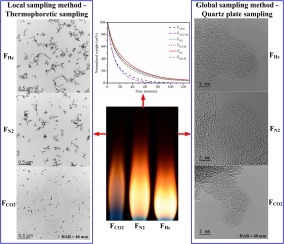Our official English website, www.x-mol.net, welcomes your
feedback! (Note: you will need to create a separate account there.)
Nanostructure evolution and reactivity of nascent soot from inverse diffusion flames in CO 2 , N 2 , and He atmospheres
Carbon ( IF 10.5 ) Pub Date : 2018-11-01 , DOI: 10.1016/j.carbon.2018.06.047 Yaoyao Ying , Dong Liu
Carbon ( IF 10.5 ) Pub Date : 2018-11-01 , DOI: 10.1016/j.carbon.2018.06.047 Yaoyao Ying , Dong Liu

|
Abstract The micro and nanostructure evolutions and reactivity of nascent soot from n-butanol-doped ethylene inverse diffusion flames in CO2, N2, and He atmospheres were studied and compared. The thermophoretic sampling technique was employed to capture soot particles directly at different positions along the flame boundary. Transmission electron microscopy was applied to obtain the particle morphology evolution. Moreover, high-resolution transmission electron microscopy analysis, Raman spectroscopy analysis, thermogravimetric analysis, and X-ray photoelectron spectroscopy were performed to study the nanostructure and oxidation reactivity of soot from the quartz plate sampling. It was found that soot inception rate was reduced in CO2 atmosphere, indicating CO2 could inhibit soot formation through inception process. However, He promoted soot formation since the soot agglomerate amount was larger than those in flames with CO2 and N2. High correlations were found between soot nanostructure and reactivity. The soot from CO2 atmosphere had shortest fringe length and largest fringe tortuosity related with highest oxidation reactivity. On the contrary, soot from He diluted flame exhibited prevalent fullerenic-like nanostructures with evident large or small shells, and also had a higher carbonization degree resulting in lower oxidation reactivity. The surface oxygen content related to soot oxidation reactivity.
中文翻译:

CO 2 、N 2 和He气氛中逆扩散火焰产生的新生烟尘的纳米结构演化和反应性
摘要 研究并比较了正丁醇掺杂的乙烯逆扩散火焰在 CO2、N2 和 He 气氛中产生的新生烟尘的微米和纳米结构演变和反应性。热泳采样技术被用来在沿火焰边界的不同位置直接捕获烟尘颗粒。应用透射电子显微镜来获得颗粒形态演变。此外,还进行了高分辨率透射电子显微镜分析、拉曼光谱分析、热重分析和 X 射线光电子能谱分析,以研究来自石英板采样的烟灰的纳米结构和氧化反应性。发现在 CO2 气氛中烟尘起始速率降低,表明 CO2 可以通过起始过程抑制烟尘形成。然而,他促进了烟灰的形成,因为烟灰团块的数量比 CO2 和 N2 火焰中的大。在烟尘纳米结构和反应性之间发现了高度相关性。CO2 大气烟尘具有最短的边缘长度和最大的边缘弯曲度,与最高的氧化反应性有关。相反,He稀释火焰产生的烟尘表现出普遍的类富勒烯纳米结构,具有明显的大小壳,并且具有较高的碳化度,导致较低的氧化反应性。表面氧含量与碳烟氧化反应性有关。CO2 大气烟尘具有最短的边缘长度和最大的边缘弯曲度,与最高的氧化反应性有关。相反,He稀释火焰产生的烟尘表现出普遍的类富勒烯纳米结构,具有明显的大小壳,并且具有较高的碳化度,导致较低的氧化反应性。表面氧含量与碳烟氧化反应性有关。CO2 大气烟尘具有最短的边缘长度和最大的边缘弯曲度,与最高的氧化反应性有关。相反,He稀释火焰产生的烟尘表现出普遍的类富勒烯纳米结构,具有明显的大小壳,并且具有较高的碳化度,导致较低的氧化反应性。表面氧含量与碳烟氧化反应性有关。
更新日期:2018-11-01
中文翻译:

CO 2 、N 2 和He气氛中逆扩散火焰产生的新生烟尘的纳米结构演化和反应性
摘要 研究并比较了正丁醇掺杂的乙烯逆扩散火焰在 CO2、N2 和 He 气氛中产生的新生烟尘的微米和纳米结构演变和反应性。热泳采样技术被用来在沿火焰边界的不同位置直接捕获烟尘颗粒。应用透射电子显微镜来获得颗粒形态演变。此外,还进行了高分辨率透射电子显微镜分析、拉曼光谱分析、热重分析和 X 射线光电子能谱分析,以研究来自石英板采样的烟灰的纳米结构和氧化反应性。发现在 CO2 气氛中烟尘起始速率降低,表明 CO2 可以通过起始过程抑制烟尘形成。然而,他促进了烟灰的形成,因为烟灰团块的数量比 CO2 和 N2 火焰中的大。在烟尘纳米结构和反应性之间发现了高度相关性。CO2 大气烟尘具有最短的边缘长度和最大的边缘弯曲度,与最高的氧化反应性有关。相反,He稀释火焰产生的烟尘表现出普遍的类富勒烯纳米结构,具有明显的大小壳,并且具有较高的碳化度,导致较低的氧化反应性。表面氧含量与碳烟氧化反应性有关。CO2 大气烟尘具有最短的边缘长度和最大的边缘弯曲度,与最高的氧化反应性有关。相反,He稀释火焰产生的烟尘表现出普遍的类富勒烯纳米结构,具有明显的大小壳,并且具有较高的碳化度,导致较低的氧化反应性。表面氧含量与碳烟氧化反应性有关。CO2 大气烟尘具有最短的边缘长度和最大的边缘弯曲度,与最高的氧化反应性有关。相反,He稀释火焰产生的烟尘表现出普遍的类富勒烯纳米结构,具有明显的大小壳,并且具有较高的碳化度,导致较低的氧化反应性。表面氧含量与碳烟氧化反应性有关。











































 京公网安备 11010802027423号
京公网安备 11010802027423号